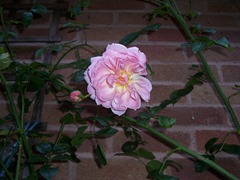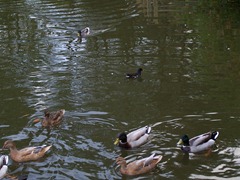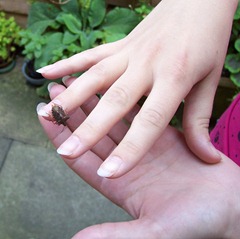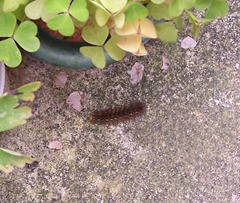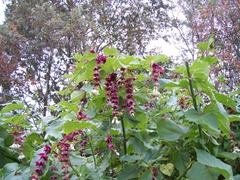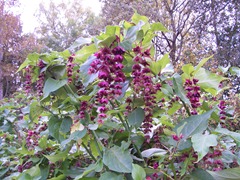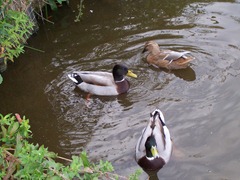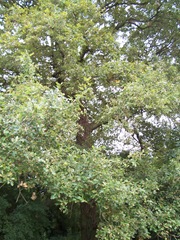This year I have been rewarded once more with my cactus. Traditionally these are often called Christmas cactus. Mine, this specimen, has flowered all through the year with just a few small rest periods. This was achieved by observing that the plant flowers after a small drought period. I feed and water it well whilst it is in flower then when all of the flowers die off – I allow the plant to rest. I leave it dormant without watering for four to six weeks. Once the soil is very dry I give the plant a good soaking with a small splash of plant food. Small buds then appear on the tops of the outer leaves. Once these are apparent then I feed and water well until the plant has finished its magnificent display of large bright flowers. Then I allow the plant to rest once again.
Random Ramblings
The letter
There once was a young girl, laughing, happy and cheerful as all young girl’s should be. One day something terrible happened in the young girls life. Here is the police account and what she bravely did to address the problem:
Hebe – Purple Pixie
The most unusual thing about this year are the amount of various plants that have either come into bloom several times or those like the Hebe Purple Pixie which has flowered non-stop from Spring until now … It still shows no sign of dying back for the Winter.
Spider plant
I have grown Spider plants for years. It was not until two years ago that I decided to plant one in an outside tub for extra foliage. To my surprise this soft houseplant survived the Winter and remained growing in the pot outside. The following year I added a few more here and there and this year I have put them into the hanging baskets. They are probably the most easiest of all houseplants to grow as they throw off a long stem or two which has little white star like flowers bloom as these little flowers die off, tiny little plants begin to sprout on the stem. These are best left until they are a few inches tall, by which time the root buds can be seen on many of them. Gently break them off from the parent plant and place in a jam jar with a little water and the roots will grow at tremendous speed. The little plants can then be added either inside or outside the house.
Spider plants are a very useful addition to the family home as they have an ability to remove the toxins created by raw wood helping to create a more healthy environment.
White heather
It’s December, almost Christmas and in the garden the White Heather also known as ‘Lucky Heather’ is now in full bloom. Remember to break off a couple of small stems of it and put one at your front door and the other at your back door (either inside or out or if you have plenty then both). This is supposed to mean that every time any person crosses the threshold of your home, whether through the front or back door they bring good luck into your home to all who dwell in it or visit it. From time-to-time, we all need a little good luck. It is one of the most easiest of all of the heathers to grow and will snuggle down into a small crack of soil so is well worth planting.
Soldier
‘The Services:
Army, Royal Air Force, Navy - people who join the Services love their job and their country more than life itself. They are the ultimate patriots and the rest of us could never come close to what they are prepared to give.’ Anon
 Picture courtesy of 'Tommy: the British Soldier in combat mission.'
Picture courtesy of 'Tommy: the British Soldier in combat mission.'
Worcestershire
Worcestershire is like an old tapestry – rich, ancient and complex in its make-up with wonderful names that are entwined in the mesh of its very detailed history. The names of its rivers and hills date back to the first people who walked and farmed the land well before its many invasions by warring warriors. Hills were just often called hills in the ancient tongue and so as various areas became invaded then a new word for hill would be added and so the title of the hill became in actual fact ‘hill hill’ – one version from each language.
Worcester is the largest town in the county of Worcestershire. Its people, it is believed originate from a tribe of people who were linked to the winding river and it is alleged were called the Weogora tribe. The town centre was known as Wirecestre around the time of The Doomsday Book.
The weather in Worcestershire today:Frostbite
The first day of the month of December has arrived and with it a severe drop in the temperature. Over night it fell by several degrees below zero and so came … the frost. Plants that were soft, delicate, tender and vulnerable have been chewed away by the ice crystals.
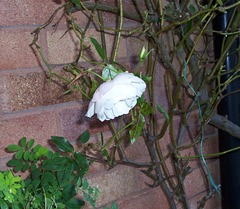 A few slightly bruised looking flowers after the 1st December frost
A few slightly bruised looking flowers after the 1st December frost
Why not … eat insects
I was fascinated to learn that it was once popular to eat insects in Britain. In fact, it is still possible to purchase a small but useful book that was written by Vincent M Holt in the 1800’s. For those who like to read interesting little books, this one contains just 99 pages. It is called ‘WHY NOT EAT INSECTS?’ The ISBN number is: 0946014124 – it is still in print and readily available for purchase.
There are all sorts of recipes that are bordering, to say the very least, on the unusual – from wasp grubs fried in the comb to wireworm or woodlouse sauce – the latter two obviously not insects. The knowledge of eating safe pests has been gathered over the years from various countries spanning the globe.
 Little book ‘Why Not Eat Insects?’
Little book ‘Why Not Eat Insects?’
The little book also mentions other things that may be considered for the pot – one being snails or slugs. These apparently have to be pulled from the garden and starved for several days. This then allows them to purge their systems of anything poisonous in case they may have eaten something that would or could prove to be dangerous to us!
Money sayings
As a child I would love to curl up in a ball and listen to the different sayings that older people would utter. I would wonder about who the original person was that had thought up such advice. Were they old and wise with deep set wrinkles, full of life's experiences? Did such knowledge arrive when they were still young and full of bloom? Would knowledge like this suddenly descend upon me? Here are a few of the sayings that were often used by the older members of the community whilst I was growing up:
‘One hundred pounds of your own money is worth more than a thousand of somebody else’s.’
‘A bird in the hand is worth two in the bush.’
‘Spend a bit, owe a bit, save a bit.’
‘Never a lender or a borrower be.’
‘The rich will always know how to smile – but only the poor know how to laugh.’
‘If they paid a working man a worthy wage then he would never work again!!’
‘A fool and his money are easily parted.’
There are of course many more and if nothing else they certainly make a person think!
We are like other mammals
I think that we should all readily accept that we are mammals. Although, we supposedly are set apart from other mammals because we have the power of reason that may, in some ways, be our eventual undoing. We are born from the earth and whether we like it or not are connected to every other living form on the planet. Ancient man with his closeness to nature had no problem knowing and believing his closeness to other life forms. We are better educated but try to distance ourselves from this despite there being irrefutable proof through DNA that we share our origins with all other life forms. We should not need such evidence to make us respect the life on our planet … we are after all chosen as the leaders of life here on earth … it is our job to police it … to protect it …. to nurture it … to appreciate it … and most of all to love it … all of it – no matter how repugnant we may find it. All life is precious and we walk on a tightrope of existence – if man is to flourish then so must the delicate balance of all life around him. We are not gods, therefore we should never assume that we have the power over life or death without consequence - so we must choose our roads with extra caution if we want any kind of future for mankind.
Mole
The other day I came across a molehill. It was only a fairly small one which means that the soil beneath is lovely and deep. Large molehills usually grouped together are known as fortresses – these occur when the soil is fairly shallow or in areas that may have a propensity to flood. These molehills are often quite high.
Moles spend their life underground so the molehill is usually the only sight the majority of people see – but just occasionally, if you see a molehill being formed you may be lucky enough to catch sight of a little pink nose. Moles live from between one to three years. The female mole is known as a sow and the male as a boar and a small group of moles are referred to as a labour – a very apt name as they are such construction experts and extremely hard working. Their saliva has the ability to paralyze small creatures such as earthworms – this is necessary as they hold the worms between their paws and push out all of the soil and sediment in the worms guts before eating them. They will also eat fly and beetle larvae and very occasionally have been known to catch a passing mouse!
Weather whip
This year, global warming has become far more noticeable. All around us there are warning bells tolling out but rather than shattering peels they are leaving us visible clues. Although we are well into November everything around is whispering ‘October.’ The temperature, the winds, the rainfall, the insects … there are still wasps busily buzzing about! Hedgehogs are still out and about busily nuzzling their way on the lawns and in the borders. Pigeons are fluttering in the hedges and pecking off the ruby red berries.
As a young girl my mother would always use the following phrase when November descended onto us -
“No sun, no moon, November!”
November was always like this full of swirling mists and fogs. Everything dripping wet and damp. The damp travelled everywhere and elderly people would rub at their arms and legs to try and ease the aching as the dampness appeared to creep deep into their bones. Washing that had been hung on the line would come in wetter than when it had been hung out. People developed hacking coughs and streaming colds. Bronchitis was more of an occupation than an ailment and it tore into lungs as deadly as a surgeon’s scalpel.
…… Our Novembers have changed. Although this means that the planet is warming up at a dangerously fast rate, I would not wish for Novembers to return to what they once were ……
 The cat is more playful this November … the basket and sleep are waiting for another time!
The cat is more playful this November … the basket and sleep are waiting for another time!
Shield bug
I saw my first shield bug only a few years ago and in some ways it reminded me of the stick and leaf insects from far off lands. I instantly became enchanted with this lovely little creature. In the Spring and early Summer the common variety is plain green occasionally having a few tiny pin spots. The bug’s wings change to an interesting brown in the Autumn. It’s appearance seems to mimic the seasons and so may be regarded as the chameleon of the insect world. It will gently ascend onto an outstretched hand and slowly walk a few steps and then just settle and stay in a still position. There is no sting or bite to worry about but do take care to treat these lovely bugs gently as their country name is ‘stink bug’ as they can exude an extremely unpleasant smell from their hind quarters if they feel threatened.
Shield bug in Autumn
Swine flu
There are more and more people who reach out to Fisherman’s Friend lozenges at the first signs of a cold or flu. Amazingly it is now being alleged that one of the main ingredients is also found in Tami flu … and so they are flying off the shelves all over the world as people are now sucking these tasty lozenges as an extra precaution to hopefully remain free of Swine flu symptoms.
For those who live in Great Britain they may have seen the headlines as the owners of Fisherman’s Friend – Doreen and Tony Lofthouse were savagely beaten and attacked at their home. Details on the BBC News site.
For those who like a little bit of sporting fun then perhaps you may like to visit - Fisherman’s Friend sports events here.
Well … I have my packet of Fisherman’s Friend … just in case!!!
On the eleventh hour of the eleventh day of the eleventh month …
… we will remember them.
This is a very special year as sadly we have lost the last of the Veteran soldiers that returned to British shores at the end of the Great War, The First World War, the war to end all wars, WW1.
This January, Bill Stone passed away aged 108, sadly followed by Henry Allingham aged 113. Lastly in July, at the age of 111 Harry Patch followed them.
This time and this day was set aside, all of those years ago so that we would always remember the fallen and never let such a dreadful waste ever happen again. Sadly there have been other wars and other soldiers that have been maimed and killed and so now our thoughts and prayers go out to them also.
Just two minutes silence … not a lot for the price that they have all paid, is it?
My grandfather fought in the First World War. He returned home skewered and torn with shrapnel. He would never speak of any of it – it was just too dreadful to recall.
We cannot possibly even come close to imagine the hell of it all – putting on sodden boots, soaking wet socks, wet feet … week after week after week. To be cold, wet and wanting. To watch our brothers, friends and comrades being picked off one by one with a bullet through the head, bombs. Choking on gas, eyes streaming, nostrils, mouth and lungs burning, Skin being torn from bones with barbed wire and shrapnel. On the first day of war alone – Sixty-Thousand Men died … followed every day thereafter by many more. Fighting over a few feet of mud. Those who made the decisions on all sides of the war, it is alleged never, not once said ‘sorry.’ They all had so much to say sorry for. No leader of men should send their men to fight in circumstances such as this … my grandfather’s words, which were very few were something like this … ‘it was just for a few feet of soil.’
The year after the Great War had ended, in the muddy battlefield, the landscape became a sea of red as millions of poppies pushed their way up towards the sunlight and bloomed. So many flowers that there must have been one for every fallen soldier in the war. Since then we have used the red poppy as a symbol of their memory, their heroism and our love for them – all of them whoever they were. Many were just boys. Boys that became men within hours of joining up. So wear your poppy with pride on this very special day … if you can plant a small patch of poppies in your garden for the love and respect of all of the soldiers not only for those who gave their lives all of those years ago but those who are constantly putting their lives on the line for us today.
God Bless you all … we thank you all … our thoughts are with you … we all stand with you so … please take care!
Perfection
How should you measure perfection? Is it something that cannot be improved on? To me perfection is life. It is intricate in simplicity but also in detail. It makes me hold my breath in wonder. I am grateful for its vision, knowledge and experience of it. To be just here and witness it in itself is just perfection. Living here and now is … perfection.
Tillandsias – Air plants
Tillandsias fondly called Air plants are delightful and interesting plants for anyone to grow. They must not be planted into soil but instead require just a small crack in a rock or log to wedge themselves. As their ‘nickname’ suggests their prime requirement is air but like all living things they do require moisture. It is therefore essential to use a fine mister and spray around them every other day as they do need a humid environment. Although many produce flowers and therefore seeds their main reproduction route is through little shoots that appear at the base of the plant every twelve months. The Tillandsias are part of the Bromeliad family – they are the only members of this family that do not require soil to thrive.
The Tillandsias are very special little plants. They originate from both Central and South America and they have an amazing ability to not only purify the atmosphere but to regenerate it. They are therefore a very useful plant. In time they will most probably be grown in much larger numbers. Perhaps they should be given a space in every home …
Here are my little Tillandsias …
Water birds at dusk
I love to see birds as they squeeze every tiny drop of daylight to find and eat as much food as they are able before the inevitable blanket of blackness falls and covers the world for the day.
Remember, remember …
We, it appears have always had terrorists in one form or another. The Chinese gave us gunpowder and with it not only did we have great power - but like China, the British people came to know and enjoy the pleasure of seeing fireworks light up the sky with beautiful patterns and falling stars.
Puppy
When I was a young child, as with most children I yearned for my own little puppy. So I was delighted when I learned that a a very common furry caterpillar was given the nick-name of puppy. Along with other children in my area I collected them and played with them and watched them walking quickly down the garden path. The caterpillar in question is called the Garden Tiger Moth caterpillar which years ago appeared to be everywhere in late Summer and early Autumn. It has been quite a few years since I last saw one of these lovely creatures but this year I found one on my garden path and it brought back some lovely memories.
Cool for cats
November came in with a cut and a slash as the cooler winds sliced through clothing almost unexpectedly after a very balmy October. The cat’s habits changed overnight and for the last few days she has snuggled deep in her little bed sleeping for a good proportion of the time. A little older, she now has developed a rather soothing soft, melodic snore as her chest rises and falls in a steady rhythm. Sometimes her front legs shoot out and remain stiffly in position other times it’s her back legs that stray from her soft, round basket. Occasionally both front and back legs pour out at peculiar angles but still she sleeps, very deeply … In fact, it is the only place where she manages to grasp very deep sleeping periods, if she falls to sleep anywhere else in or around the house her eyes very quickly prize open at the slightest noise. Her basket, apparently offers a much safer place to reside as she rarely wakes up from her deep dreams whilst rolled up asleep, cuddled on the soft, padded bottom.
As a young child my mother would tell me the following rhymes about cats which I passed on to my own children …
Pussy cat Mole
Pussy cat Mole Jumped over a coal, And in her best petticoat Burnt a great hole.
Poor pussy is weeping She’ll have no more milk Until her best petticoat is Mended with silk.
I Love Little Pussy
I love little pussy, Her coat is so warm, And if I don't hurt her, She'll do me no harm.
So I'll not pull her tail, Nor drive her away, But pussy and I, Very gently will play.
Oh my tail and whiskers – that brings back some very happy memories!
5 O’clock shadow
Today is ‘All Souls’ Day.’ The nights creep in and on overcast days it can sometimes appear surprisingly bleak.
Although this afternoon became dull and slightly blustery I managed to capture a Yew tree so full of berries that it was weighing down some of the more spindly of its branches.
*Never eat a Yew berry – they are probably the most dangerous of all of the berries. Their poison kills – so if using Yew tree branches for Christmas decorations, always thoroughly wash your hands!
All Saints Day and the Peace lily
Today is All Saints Day, the first day of the old Celtic New Year, a day of peace and the perfect day to purchase a Peace lily. The Peace lily is the ultimate house plant. It only requires a very small amount of natural light and helps to keep optimum humidity to modern homes. This lovely plant absorbs all of the modern chemicals that float about in the air and replaces them with pure oxygen. This process goes on whether the plant is flowering or in a dormant period. It usually rests for eight weeks before coming into full bloom once again. Some people call it the ‘tear drop’ plant as it is said to cry in a happy home taking away any misery. Remember to keep the soil damp for a healthy plant.
Hallowe’en, All Hallows Ev’e or plain Halloween
Halloween still remains in the cycle of the year despite its very pagan origins. Celebrated over 2000 years ago by the Celts, more in anguish than in full cheerful abandonment. There are many beliefs entwined around the 31st October, all are to do with conjuring up the dead. Pagans threw their prayers in many directions but October brought the end of their year and it carried with it such powers as to summon the dead. Superstition was commonplace and so people were terrified on this special night. Many different ways of dealing with the worry of this emerged over the years.
Perhaps we should be wary of making it into a celebration when it may be more sensible for Halloween to be forgotten – it is sometimes said that ‘it is better to let the past stay in the past.’
The last day of October, ‘Halloween’ had long been forgotten and remained dormant in our history until around 1500 AD. The word ‘Hallow’ is a very old word that represents the meaning of ‘a saint’ and was therefore most probably used as Halloween, originally referred to as ‘all Hallows Eve’n’ was the day before ‘All Saints Day.’ All Saints Day was the first day of the Celtic New Year and was therefore embedded into the Celts way of life. The early Celts were afraid of the long dark period of time as nights became ever longer and the day light increasingly shorter. They believed that especially on the night before the New Year the barrier that kept the dead world away from the living world was especially thin and weak and that the stronger spirits could break through and leave their dead world to walk amongst the living. It became a custom for people to gather wood and build high fires which it was believed would help to keep the dead where they belonged and should any have escaped and be walking amongst the living, the fires would offer protection and would help to banish the escaped spirits away.
Fuchsia quandary
This year has presented a most unusual flowering pattern for the fuchsias in the garden. I try to add a few annual varieties to my little hardy collection most years. The established ones that are scattered in the borders and one or two tubs were very late in showing any kind of life at all earlier in the year. I wondered whether, in fact, they had all perished in the Winter but decided to leave them alone. Eventually I was rewarded with tiny shoots along the woody stems. Unlike last year however the flowers were very sparse indeed.
The indoor or annual varieties which were full of blooms in the nursery soon also developed into spasmodic flowering episodes. Some are now in full bloom and there appear to be more flowers on one of these ‘house’ plants than on any other time of the year.
Fuchsias are really easy plants to take cuttings from. Simply snip off a stem to approximately one to two lengths of your thumb – gently remove the bottom four leaves from the stem – use a small lollipop stick or old twig as a dibber – make a hole in the soil about half a thumb or slightly longer in length – gently push in the fuchsia cutting and press either side of it to firm it into the ground – then water. When the plant has been growing for twelve weeks pinch out the top two leaves to make it bush … if a small tree is required then wait until the stem is the desired length before pinching out the top two leaves. Remember when a small tree is needed, it may be necessary to remove small stems from the bottom of the main baby trunk.
Leycesteria formosa
Leycesteria formosa has been introduced into many countries because of it offers beauty with hardiness. It is known throughout the world by many different names, the most common of which is Pheasant berry, Himalayan honeysuckle, Himalayan nutmeg or Flowering nutmeg. The plant originates from the Himalayas and areas of South-West China. This very picturesque shrub could make a lovely addition to any garden as the flowers are graceful in their formation. Small white fragile looking stars dangle daintily at the end of the dark plum leaflet trail. Bees hover around the flowers throughout the whole of July and August. Towards the end of the flowering season, deep into Autumn lush, dark, rich damson-red berry fruits hang from each small leaflet and these are prized by blackbirds.
It is a plant that loves sunshine but will do well in partial shade. Although it is known to be self-contained when planted in Britain there have allegedly been a few reports that it has become quite rampant in New Zealand.
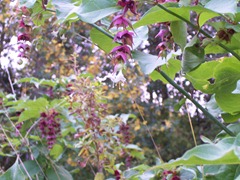 Leycesteria formosa – also known as Himalayan honeysuckle, Pheasant berry, Himalayan nutmeg, Flowering nutmeg and loving called ‘Purple shrimp flower’
Leycesteria formosa – also known as Himalayan honeysuckle, Pheasant berry, Himalayan nutmeg, Flowering nutmeg and loving called ‘Purple shrimp flower’
These particular plants were an unexpected find in Arrow Valley Nature Reserve in Redditch, Worcestershire, England and I personally think that they are very beautiful.
Great Reedmace at Twilight
For people who enjoy rough beauty, there is an area almost at the edge of the Worcestershire boundary called Ipsley Alders Nature Reserve. It is a beautiful stretch of land that is wild and rambling with all sorts of features for a naturalist to enjoy. One of the many plants that I found growing there was extremely tall Great Reedmace otherwise known as Bulrush … when standing close I had to crane my neck to see them against the skyline.
The female part of the plant is the fat sausage that sits towards the top of the long stem – the male is the rough area above her … when pollinated the female part of the plant releases beautiful, soft cotton silk like down which carry the seed. The plant likes to root itself in fresh water edges of lakes, ponds, rivers, canals, streams and brooks. The Latin name for this wonderful primitive looking plant is: Typha latifolia.
It has a cousin that is similar but this plant has a large fat sausage female with a short gap followed at the very top by a smaller narrow leaner sausage male – one on top of the other. This plant is called Lesser Reedmace or Lesser Bulrush. Latin name: Typha angustifolia.
Lake island
I took a stroll around Arrow Valley Lake and happened to glimpse one of the two islands that lie somewhere near to the centre of the lake. There are very few spots when they actually look like islands rather than part of the far bank landscape. This is the smaller of the two islands and the sun came out and kissed the view just in time for me to capture the beauty of it all.
 Small lake island at Arrow Valley Country Park
Small lake island at Arrow Valley Country Park
Mallard
Mallard are probably Britain’s most well known and loved ducks. They are found swimming and waddling on most of our waterways and lakes and are extremely social and friendly apart from one or two that are shy and always remain a discrete distance from humans. The drake is beautifully coloured and has a dark green almost iridescent head. The call of the female mallard is a very loud ‘quack’ – similar to a farmyard duck but the brightly coloured male has a weaker, softer but higher pitched call that can sound more like a squashed ‘queck querk’ some even make the noise of a faint horn ‘quarrk.’
In early Autumn several males will fly after a female and then swim round and around her displaying themselves for her to make a choice. This gentle courtship becomes more wild and rough as the season progresses and eventually males force themselves onto females in what could be described as bird ‘rapes.’ The ducks pair off early in the year and will fly to their breeding grounds …
Little note: the male bird is called the drake and the female the duck. The young are able to fly before they reach the age of seven weeks. They often can be seen dabbling (up-tailing) to get their food.
‘Ducks Ditty’ from Wind in the Willows
All along the backwater,
Through the rushes tall,
Ducks are a-dabbling,
Up tails all!Ducks' tails, drakes' tails,
Yellow feet a-quiver,
Yellow bills all out of sight
Busy in the river! "Slushy green undergrowth,
Where the roach swim—
Here we keep our larder,Cool and full and dim.
Everyone for what he likes!
We like to be
Heads down, tails up,Dabbling free!
High in the blue above,
Swifts whirl and call—
We are down a-dabbling,Up tails all!
written by Kenneth Grahame
White aster
This beautiful, elegant daisy like flower was found adorning the water’s edge at Arrow Valley Nature Park in Redditch, Worcestershire. These pictures of the flower were taken in October and shows its snow white flowers growing in clusters at the top of long, dark leaf stems. There were so many of these plants, each tipped with their sprays of flowers that they looked breathtaking against the dark ripples of the water.
Wild White Aster
Copper fountain
I have recently revisited the beautiful hand-made copper fountain that resides beside the Nature Centre at Arrow Valley Nature Centre. This was lovingly created by school children and has a mixture of lilies, fish, dragonflies, great reedmace otherwise known as bulrushes and two cranes that play peepo with visitors as they rise and fall alternately. The first time that I saw the fountain I thought that the birds were herons but thankfully a reader corrected this. Original post reads …
Thumb sucking
Thumb sucking is probably the most addictive activity that a human being can ever have knowledge of. For babies who begin gleefully sucking their thumbs in protection of the womb it releases the wonderful uplifting chemicals within the brain. Infants and young children who carry on the carefree habit enjoy the comfort and the feeling of well being. Serotonin flowing to ease the stresses and worries and make the world a much brighter place.
Yet – thumb sucking is frowned upon when a child grows but perhaps it shouldn’t be. In fact, should more research be done to see whether this simple, free activity could be the answer to many adults who take masses of drugs to counteract stress. Many are advised to take 5-HTP Serotonin Tonic – Happy Days … perhaps all they need is to follow their childhood instinct.
Heart of oak
Come cheer up, my lads,
'tis to glory we steer,
To add something more
To this wonderful year,
To honour we call,
Not to press you like slaves,
For who are so free
As the sons of the waves?
Heart of oak are our ships,
Jolly tars are our men,
We always are ready,
Steady, boys, steady,
We'll fight and we'll conquer
Again and again.
We ne'er see our foes …
But we wish them to stay,
They never see us
But they wish us away,
If they run, why we follow,
And run them ashore,
And if they won't fight us,
We cannot do more.
Heart of oak are our ships,
Jolly tars are our men,
We always are ready,
Steady, boys, steady,
We'll fight and we'll conquer
Again and again.
They swear they'll invade us,
These terrible foes,
They frighten our women,
Our children and beaus,
But should their flat bottoms
In darkness get o'er,
Still Britons they'll find
To receive them on shore.
Heart of oak are our ships,
Jolly tars are our men,
We always are ready,
Steady, boys, steady,
We'll fight and we'll conquer
Again and again.
Our worthy forefathers,
Let's give them a cheer,
To climates unknown,
Did courageously steer.
Through oceans to deserts,
For freedom they came,
And dying, bequeathed us
Their freedom and fame.
Heart of oak are our ships,
Jolly tars are our men,
We always are ready,
Steady, boys, steady,
We'll fight and we'll conquer
Again and again.
Written by David Garrick in the year of our Lord 1759
Quercus robur – the English Oak
The oak is the backbone of Britain and there is much in our history to show how important this beautiful ancient tree is. The English oak lives up to 800 years some occasionally reach a few years more. It is a hard wood deciduous tree and has been protected for hundreds of years – this applies whether it has an accidental birth through an odd fall of an acorn or has been purposely planted. Permission must always be sort to fell an oak - even if it is on your land and may be close to your home, growing perhaps just a few feet from your own front door – you cannot chop it down.
An oak with acorns
There are many legends entangled in the history of the oak tree. It was considered to be one of the most sacred of trees ‘the tree that the gods sought out in the mighty storms.’ It is thought that in ancient times, lightening was (and in fact still is) attracted by the tallest of the oaks which would often split down the trunk at the centre of the tree and so become ‘touched’ by the gods. The wood of the tree would thus be considered to be very special timber with exceptional powers of strength and durability.
Oaks were used to build British ships hundreds of years ago but they reached their most dangerous in their swiftness and sureness when copper was attached to their prow. Rather like modern athletes requiring sleekness for speed – ancient ship builders found that by adding copper the prow of the ship kept clear of life (not one barnacle would attach itself to the copper and this kept the line of the ship sharp and it was able to cut through the water with frightening aggression). It was both the oak and it’s copper adornment that gave Britain the edge as the 80 English galleons chased the Spanish Armada.










